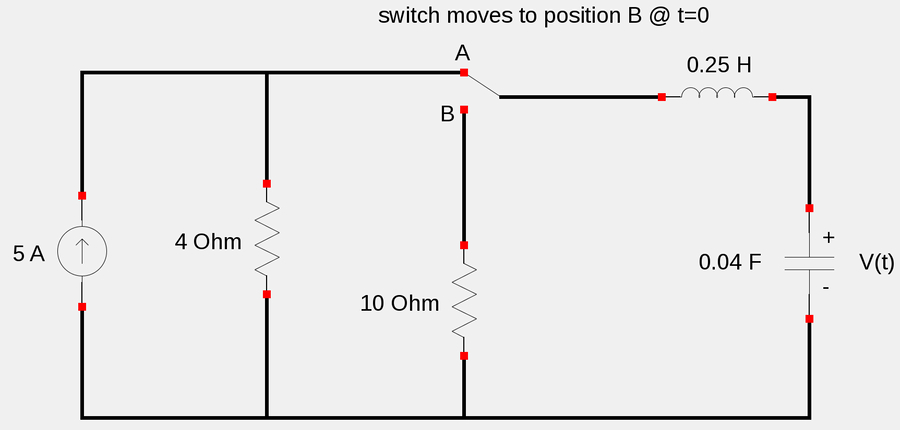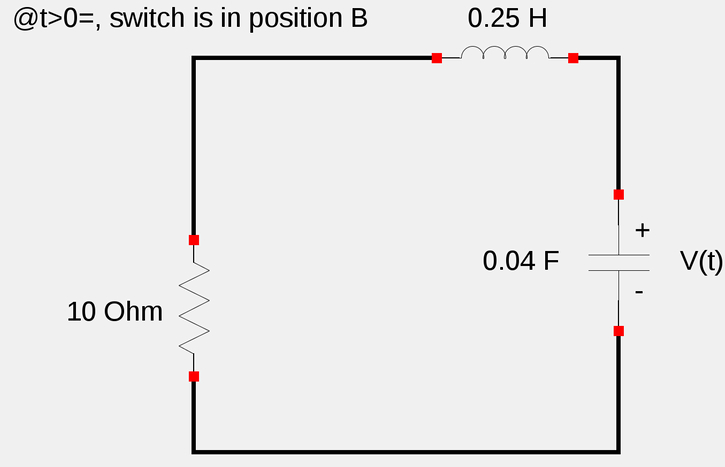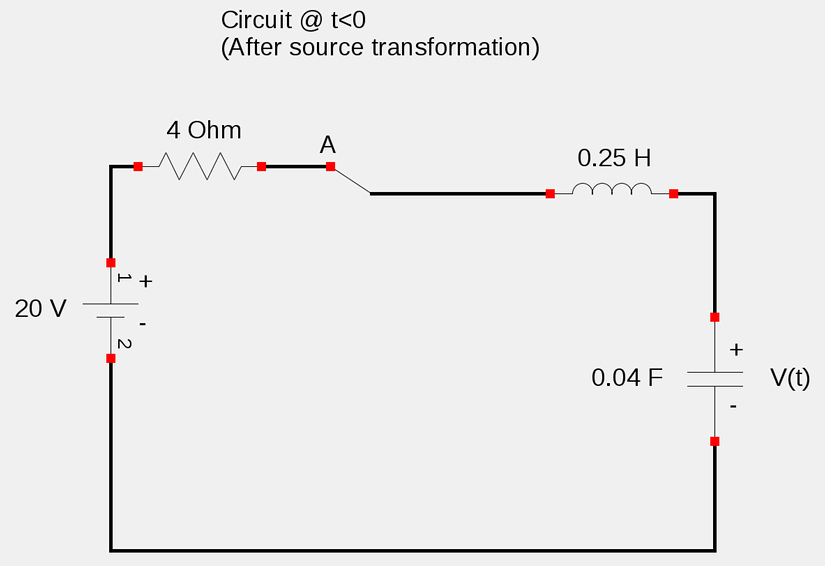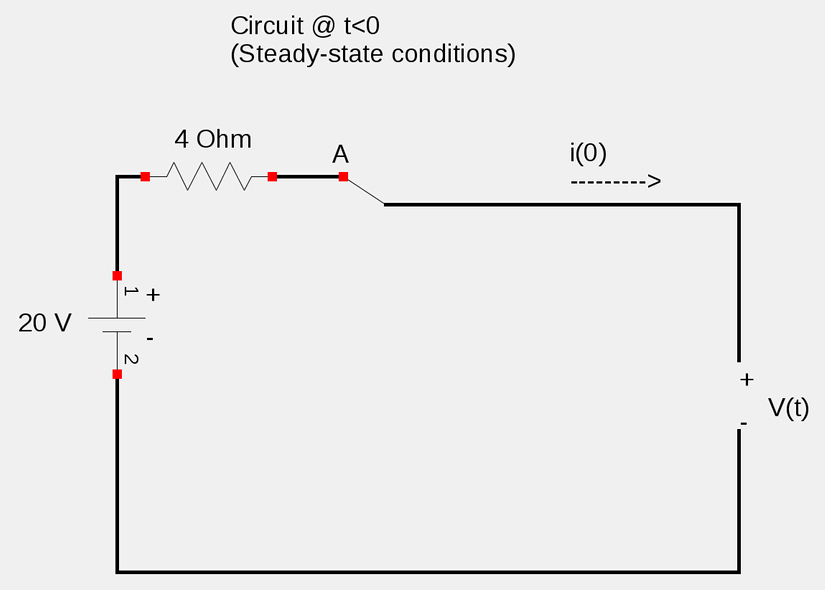For the following circuit...

Find v(t) for all t>=0
First lets obtain a second order differential equation that represents the natural response of the RLC circuit. The natural response occurs at t>=0 and the current source is effectively disconnected. (as shown below):

By using Kirchoff's Voltage law and as well as the following definitions of voltage for our 3 circuit components:
$$V_R = iR $$
$$V_L = L\frac{di}{dt} $$
$$V_C = \frac{1}{C} \int_{}^{} i \; dt $$
...we obtain the following 2nd order differential equation by summing the individual voltages as we travel around the circuit:
$$10i + 0.25i' + \frac{1}{0.04}\int {}^{}i \; dt = 0 $$
By taking the derivative of the above equation, rearranging terms and dividing through by 0.25, we get:
$$i'' + 40i' + 100i = 0 \qquad , \; (Eqn \;1) $$
Equation 1 is a 2nd order differential equation. Once again we go about solving it by assuming that solutions are of the following form:
$$i = e^{st} $$
...and where the 1st and 2nd derivatives of i(t) are the following:
$$i' = se^{st} $$
$$i'' = s^2e^{st} $$
Substituting the above three expressions into eqn 1 gives us:
$$s^2e^{st} + 40se^{st} + 100e^{st} = 0 $$
We can divide out the exponential terms
$$s^2 + 40s + 100 = 0 \qquad , \; (Eqn \;2) $$
Eqn #2 is the "characteristic equation of eqn #1. To find the roots of the characteristic equation (values of s) we use the quadratic formula:
$$s = \frac{-b \pm \sqrt[]{b^2-4ac}}{2a} \qquad ,(Quadratic \;formula)$$
$$s = \frac{-40 \pm \sqrt[]{-40^2-4(1)(100)}}{2(1)}$$
$$s = -20 \pm 17.32 $$
$$s_1 = -2.680$$
$$s_2 = -37.32 $$
Substituting s1 and s2 into our definition for i(t) gives us the 2 solution fundamental set of:
$$f.s. = \{e^{-2.680t}, e^{-37.32t}\} $$
Recall that for a 2nd order Homogeneous differential equation, any constant multiplied by a solution is also a solution. Therefore:
$$f.s. = \{Ae^{-2.680t}, Be^{-37.32t}\} $$
Additionally, given two unique solutions to a 2nd order homogeneous differential equation, the sum of those two unique solutions is also a solution. Therefor, the general solution to equation #1 is the following:
$$i(t) = Ae^{-2.680t} + Be^{-37.32t} \qquad (Eqn \; 3)$$
Solving for constants A and B
In order to solve for the constants of equation #3 (our general solution), we will need to determine numerical values for i(0) and i'(0). In order to do so let's consider the circuit at t<0 (as shown below):

In order to simplify things (and refresh some basic skills), let's use a source transformation technique to convert the above current source, which is in parallel with the 4 Ohm resistor, into a voltage source in series with the 4 Ohm resistor. While Thevenin and Norton equivalent circuits aren't explained in detail here, we will proceed as follows:
$$R_{TH} = 4 $$
$$I_N = 5 $$
$$V_{TH} = R_{TH}(I_N) = 5(4) = 20V$$
This gives us the following equivalent circuit:

We will assume that the switch has been in position A for a long enough time to display steady-state characteristics. We know that in such conditions the inductor acts as a short while the capacitor acts as an open circuit. Such condtions for the circuit are represented below:

We also recall that inductor current and capacitor voltage can't change instantaneously such that:
$$i(0^-) = i(0) = i(0^+) $$
$$v(0^-) = v(0) = v(0^+) $$
...where the positive and negative signs represent times just before and just after the changing of the switch position. Therefor:
$$i(0) = 0A $$
$$v(0) = 20 V $$
In order to find a numerical value for i'(0), we will revisit our circuit at t>=0 (as shown below):

...and using Kirchoff's Voltage law around the circuit for time t=0 gives us:
$$Ri(0) + Li'(0) + v(0) = 0 $$
$$10(0) + 0.25i'(0) + 20 = 0 $$
$$0.25i'(0) = -20 $$
$$i'(0) = -80 $$
Knowing values for i(0) and i'(0), we can proceed to set up a system of 2 equations and two unknowns:
$$i(0) = Ae^{-2.68(0)} + Be^{-37.32(0)} = 0 $$
$$A + B = 0 \qquad(Eqn \; 4) $$
Taking the derivative of eqn 3:
$$i(t) = Ae^{-2.680t} + Be^{-37.32t} $$
$$i'(t) = -2.68Ae^{-2.680t} -37.32 Be^{-37.32t} $$
...and setting it equal to zero:
$$i'(0) = -2.68Ae^{-2.680(0)} -37.32 Be^{-37.32(0)} = -80$$
$$-2.68A -37.32 B = -80 \qquad(Eqn \; 5)$$
Using whatever technique you prefer to solve the system of equations for equations 4 and 5 gives you the following values for A and B
$$A = -2.31 $$
$$B = 2.31 $$
...which gives us the final expression for i(t) for all t>0 :
$$i(t) = 2.31e^{-37.32t} - 2.31e^{-2.68t} $$
Finding v(t):
Recall the definition for voltage across a capacitor:
$$v(t) = V_0 + \frac{1}{c} \int_{}^{} i \; dt $$
...and substituting our above determined numerical value for v(0) as well as c (capacitor value) and expression for i(t):
$$v(t) = 20 + \frac{1}{0.04} \int{}^{} [2.31e^{-37.32t} - 2.31e^{-2.68t}]dt $$
$$ v(t) = 20 + 25[-0.0619e^{-37.32t} + 0.8619e^{-2.68t} + C] $$
$$ v(t) = 20 + 25C - 1.548e^{-37.32t} + 21.55e^{-2.68t} \qquad(Eqn \; 6)$$
Now we will determine the constant of integration (C) by again using our above determined numerical value for v(0)
$$ v(0) = 20 + 25C - 1.548e^{-37.32(0)} + 21.55e^{-2.68(0)} = 20$$
$$ 20 + 25C - 1.548 + 21.55 = 20 $$
$$25C + 40 = 20 $$
$$C = -0.8 $$
We now substitute the above value for C into equation #6:
$$v(t) = 20 + 25(-0.8) - 1.548e^{-37.32t} + 21.55e^{-2.68t} $$
...And we get our final expression for v(t) for all t>0 (rounded to three significant figures):
$$v(t) = 21.6e^{-2.68t} - 1.55e^{-37.3t}$$
